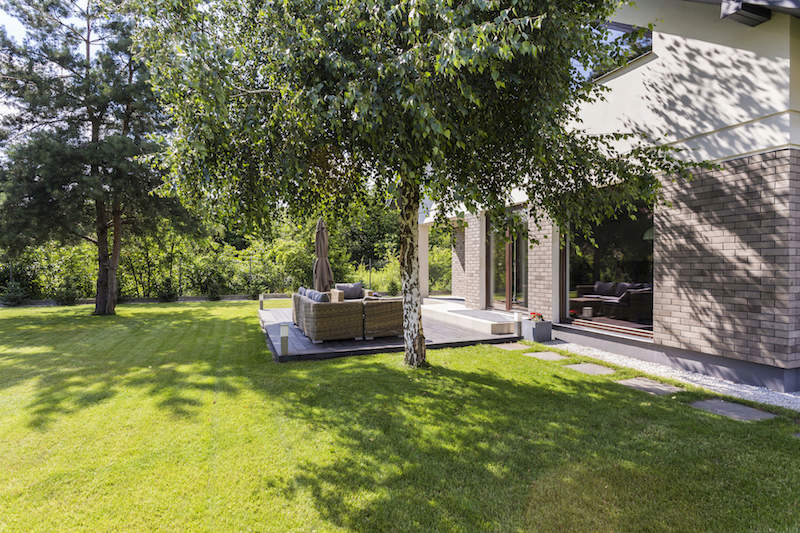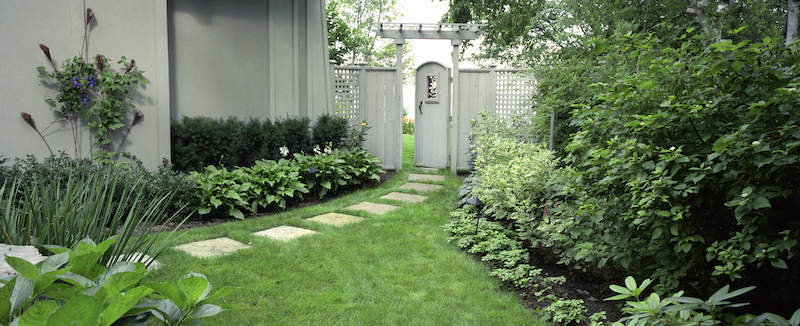All You Need to Know About Sun and Shade Grass Seed
Lawn grasses vary in the amount of sun they need to stay healthy, look great and perform well. Some types need full, direct sun all day to do their very best. That can be a problem when your landscape is a mix of sun and shade.
Shade trees, shrubs and buildings all create shady areas that shift throughout the day and change throughout the year. When parts of your yard get sun and shade, a versatile grass mix such as Pennington Smart Seed Sun and Shade Grass Seed and Fertilizer Mix or Pennington Smart Seed Southern Sun and Shade Grass Seed and Fertilizer Mix can help you get outstanding results under both conditions.
- Sun and Shade Grass Seed at a Glance
- Best Grasses for Sun and Shade Lawns
- Sun and Shade Lawn Care Calendar
Sun and Shade Grass Seed at a Glance
- Mix of superior cool-season grass varieties.
- Ideal for sunny to moderately shady areas.
- Excellent drought tolerance.
- Improved disease and insect resistance.
- Thick, fine-bladed, dark blue-green lawn.

Sun levels in your lawn change throughout the day and year.
Best Grasses for Sun and Shade Lawns
When lawn professionals talk about full sun or moderate shade, they have specific amounts of sunlight in mind. "Full sun" describes areas that get eight or more hours of direct sun each day and the grasses that prefer those conditions. Medium or moderate shade areas receive four to six hours of direct daily sun. Grasses with moderate shade tolerance handle those conditions well. Most lawn grasses always welcome more sun, but not all types can tolerate lower light levels and still deliver a thick, beautiful lawn.
When your lawn runs the gamut from sunny areas to medium shade, you need a mix of lawn grasses that can do the same. By choosing a versatile mix of improved grass varieties such as those in Pennington Smart Seed's grass seed mixes for sun and shade, you can create a lawn that thrives in four to eight hours of sun each day. Improved, purebred grass varieties developed through Pennington-affiliated grass breeding and research offer excellent drought tolerance and improved resistance to lawn disease and insect pests. Plus, they create an attractive, finely textured, dark blue-green lawn in sun and shade conditions.
Turf-type tall fescue grasses anchor both our Pennington Smart Seed Sun and Shade Grass Seed and Fertilizer Mix, aimed at northern lawns, and our Pennington Smart Seed Southern Sun and Shade Grass Seed and Fertilizer Mix for southern tall fescue lawns. Moderately shade-tolerant, these tall fescue grasses excel across a wide range of climates, including the country's challenging transition zone. They flourish from your sunniest spots through medium shade.
In addition to tall fescue, these two grass seed and fertilizer mixes include perennial ryegrass, which combines moderate shade tolerance with rapid germination and quick color. Chewings fine fescue adds exceptional shade tolerance, fine leaf texture, attractive color and durability to round out these sun and shade mixes.
With northern lawns in mind, Pennington Smart Seed Sun and Shade Grass Seed and Fertilizer Mix also includes sun-loving Kentucky bluegrass, called KBG in the trade. Smart Seed KBG varieties offer light shade tolerance and improved drought tolerance along with dense, vigorous growth and the exceptional color that makes KBG a northern favorite.
Pennington Smart Seed's grass seed and fertilizer mixes for sun-and-shade lawns bring more than versatility and shade tolerance to your yard. Water-conserving Smart Seed grasses require up to 30% less water than ordinary grasses year after year for the life of your lawn, and stay green up to three weeks without watering. Plus, Pennington's fertilizer-enhanced seed coat technology speeds establishment and promotes greener grass.
For parts of your lawn that receive even less sun, turn to Pennington Smart Seed Dense Shade Grass Seed and Fertilizer Mix. The grass varieties in this premium mix can tolerate just two to four hours of sun each day. Pennington Smart Patch II Dense Shade Mix takes care of bare spot repairs in shady spots as well.

Buildings and plants affect the amount of sun and shade your lawn receives.
Sun and Shade Lawn Care Calendar
The cool-season grasses in Pennington Smart Seed's grass and fertilizer mixes for sun-and-shade lawns grow most vigorously during the cool temperatures of fall and spring. By timing your lawn care tasks to complement this natural growth cycle, your sun-and-shade lawn works with nature to look and perform its best.
Weather conditions can vary significantly from year to year and region to region. If you're unsure about typical frost and planting dates for your local area, check with your county extension agent — they can help. Keep in mind that spring comes earliest in southern regions. The same goes for winter up north. Then let your grass be your guide and follow this sun-and-shade lawn care calendar for a thick, lush lawn.

Shaded lawn areas may need less water than hot, sunny areas.
MARCH THROUGH MAY
Mowing
Start mowing when your grass begins to grow. This usually happens in sunny spots first. For the season's first mowing, mow grass 2 inches tall. Bag these first clippings in case of winter fungal disease. Then follow good mowing practices and maintain your sun-and-shade lawn at 2 to 3 inches tall.
Weed Prevention and Fertilization
To target germinating weed seeds in early spring, prevent crabgrass and other weeds in established sun-and-shade lawns with Pennington Full Season Weed & Feed with Crabgrass Control 25-0-8. Apply before soil temperatures reach 55 degrees Fahrenheit and crabgrass seed starts germinating. If you're seeding, wait at least 60 days after planting before applying preemergent herbicide.
Seeding and Overseeding
The grasses in Pennington Smart Seed Sun and Shade Grass Seed and Fertilizer Mix and Pennington Smart Seed Southern Sun and Shade Grass Seed and Fertilizer Mix germinate best when soil temperatures reach 50°F to 65°F. That makes early spring one of the best times to plant grass seed.
Bare Spot Repair
For lawn spot repairs in mixed sun and shade, turn to Pennington Smart Patch II Sun & Shade Mix. You'll see growth in as little as five days and full results as soon as 14 days. This premixed product combines Smart Seed grass seed, professional-grade fertilizer and natural wood mulch to fix bare spots in two weeks or less.
Weed Control and Fertilization
To target broadleaf weeds in your sun-and-shade lawn in late spring, wait until grass and weeds are actively growing and treat with Pennington Full Season Weed & Feed with Crabgrass Control 25-0-8. If you seeded, wait until new grass is established and you mow at least three times before you apply this post-emergent herbicide. After application, wait at least three weeks before seeding the treated area.
Watering
Water your established sun-and-shade lawn so it receives about 1 inch of water per week from irrigation and rainfall combined. Shady areas typically stay wet longer than sunny spots, so they may need less frequent watering.
JUNE THROUGH AUGUST
Mowing
Increase your mowing height to 3 to 4 inches tall during summer to encourage deeper roots and help grass resist stress. Mow often enough that you never remove more than one-third of the blade in a single mowing.
Fertilization
Treat your summer lawn to a split application of Pennington Full Season Lawn Fertilizer 32-0-5. The added iron helps keep your sun-and-shade lawn healthy and green.
Watering
Water your established sun-and-shade lawn as needed so it gets 1 to 1 1/4 inches of water each week. Water grass deeply and thoroughly to promote resilience and deep root growth.
Pest Control
Control lawn-damaging pests such as grubs, chinch bugs and billbugs with Sevin Lawn Insect Killer Granules. A single application protects for up to three months.
Soil Testing
Test your soil pH in lawn areas every three to four years. The grasses in Pennington Smart Seed's grass and fertilizer mixes for sun-and-shade lawns grow best with soil pH between 5.5 and 7.0. When tests show low pH, your lawn needs lime to restore balance and keep nutrients available.
SEPTEMBER THROUGH NOVEMBER
Mowing
Gradually return your mowing height to 2 to 3 inches. In northern lawns, keep mowing until grass growth stops. One final mow at a slightly lower height helps prepare grass for winter. In southern transitional lawns, continue mowing at normal heights.
Weed Control and Fertilization
Six to eight weeks before your first expected frost, treat active broadleaf weeds and fertilize with Pennington Full Season Weed & Feed with Crabgrass Control 25-0-8. If you're overseeding and haven't already fertilized in fall, use Pennington Full Season Lawn Fertilizer 32-0-5 and spot-treat stubborn lawn weeds instead.
Early fall is the ideal time to seed or overseed your lawn with Pennington Smart Seed's grass seed and fertilizer mixes for sun and shade lawns, whether you live in the north or in southern transitional zones. Plant seed about 45 days before your area's typical first fall frost date.
Watering
In northern lawns, gradually reduce irrigation as nature takes over. Switch from 1 inch of water per week to 1 inch every 10 to 14 days. In southern transitional lawns, continue watering so that your lawn gets at least 1 inch of water per week.
Aeration and Dethatching
Aerate and dethatch, if needed, to reduce soil compaction and remove excess thatch. The tall fescues and perennial ryegrasses in Pennington Smart Seed's sun-and-shade seed mixes rarely have thatch problems.
Leaf Management
Remove falling leaves by raking or mulching. Shady areas are especially prone to disease when leaves aren't removed.
DECEMBER THROUGH FEBRUARY
Southern Lawns
Continue mowing and maintaining your lawn, as needed, through the winter months. Supplement precipitation so that your growing lawn gets 1 inch of water per week.
Northern Lawns
Inspect your sun-and-shade lawn regularly. Keep it free from rocks, sticks and other winter debris. If de-icing salts or pet urine affect your lawn, flush damaged areas when late-winter thaws arrive.
By giving your sun-and-shade lawn a versatile mix of premium grass seed varieties specifically chosen to suit those conditions, you can enjoy a thicker, healthier, more beautiful lawn. With Pennington, you and your lawn benefit from better research, better seed and better results in sun and shade — guaranteed.
Always read product labels thoroughly and follow instructions.




